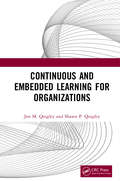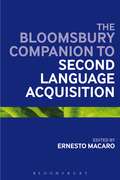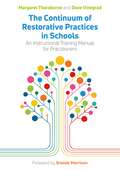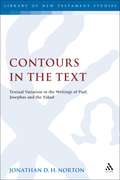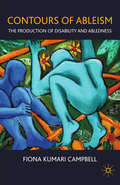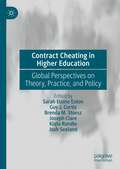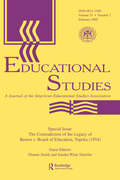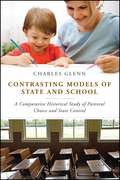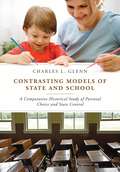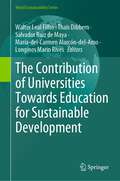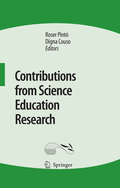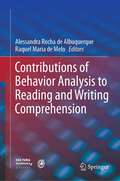- Table View
- List View
Continuous and Embedded Learning for Organizations
by Jon M. Quigley Shawn P. QuigleyThere is considerable connection between growth of the personnel in the organization and the ability for the company to compete over time. Looking outside for help training may be required but looking within for opportunities for enhanced training and growth, will foster a continually improving and growing organization. This book examines the opportunities for learning, within the organization and its’ activities, along with the connection to motivation. Additionally, it provides information on the characteristics of organizations that are able to quickly disseminate, along with approaches for improving this distribution of that learning throughout the organization.
The Continuum Companion to Second Language Acquisition (Bloomsbury Companions)
by Bloomsbury PublishingThe Bloomsbury Companion to Second Language Acquisition is designed to be the essential one-volume resource for advanced students and academics. It offers a comprehensive reference resource: it features an overview of key topics in SLA as well the key research methods. It then goes on to look at current research areas and new directions in the field by examining key relationships in the field, including the relationship between first and second language acquisition and the relationship between L2 input and L2 output.It is a complete resource for postgraduate students and researchers working within second language acquisition and applied linguistics.
Continuum Guide to Geography Education
by Graham ButtA reference guide to geography education. Entries, arranged alphabetically, cover: government legislation and reports; famous geography educators; resources; research findings; movements, trends, debates and issues; organizations; and key concepts. An analytical index helps the reader to choose paths through the book, connecting entries.
Continuum Guide to Media Education
by Pat BreretonThis is a unique, comprehensive and authoritative guide to media education in all its aspects - the key concepts, resources, research findings, movements, issues, debates, educators and organizations that characterize the subject.Presented in an easy-to-use, A-Z format, the entries constitute an invaluable one-stop resource for media educators and education students at all levels in this broad, interdisciplinary subject area.
The Continuum Guide to Successful Teaching in Higher Education
by Manuel Martinez-PonsThis definitive resource covers every aspect of teaching in higher education. Particular emphasis is placed on the two main concerns facing professors in North America and the UK today; the growing emphasis on the quality of college teaching and, more specifically, the increasingly demanding nature of the profession, whereby lecturers are forced to teach more students on a greater number of courses. Pons' practical advice is supported throughout by research evidence.
The Continuum of Restorative Practices in Schools: An Instructional Training Manual for Practitioners
by Margaret Thorsborne Dave VinegradAn instructional manual on restorative justice in schools from world-leading experts; this 'how to' guide offers guidance on the issues of carrying out restorative practices once they have been implemented in schools. It includes coping with day-to-day problems and offers worksheets for practical daily use.
Contours in the Text: Textual Variation in the Writings of Paul, Josephus and the Yahad (The Library of New Testament Studies)
by Jonathan D.H. NortonThis is an examination of Paul's possible awareness of the plurality of Ancient Jewish Scripture. Norton-Piliavsky places Paul's work within the context of ancient Jewish literary practice, bridging the gap between textual criticism and social history in contemporary discussions. The author argues that studies of ancient Jewish exegesis draw on two distinct analytical modes: the text-critical and the socio-historical. He then shows that the two are usually joined together in discussions of ancient Jewish literature arguing that as a result of this commentators often allow the text-critical approach to guide their efforts to understand historical questions. Norton argues that text-critical and historical data must be combined, but not conflated and in this volume sets out a new approach, showing that exegesis was part of an ongoing discussion, which included mutually supporting written and oral practices. Norton shows that Josephus' and Dead Sea sectarians' use of textual variation, like Paul's, belongs to this discussion demonstrating that neither Paul nor his contemporaries viewed Jewish scripture as a fixed literary monolith. Rather, they took part in a dynamic exegetical dialogue, constituted by oral as much as textual modes.
Contours of Ableism: The Production of Disability and Abledness
by F. CampbellChallenging notions of what constitutes 'normal' and 'pathological' bodies, this ambitious, agenda-setting study theoretically reinvigorates disability studies by reconceptualising it as 'studies of ableism' focusing on the practices and formations of able-bodiedness to uncover what it means to be 'able' rather than 'disabled'.
Contract Cheating in Higher Education: Global Perspectives on Theory, Practice, and Policy
by Sarah Elaine Eaton Guy J. Curtis Brenda M. Stoesz Joseph Clare Kiata Rundle Josh SeelandThis edited volume—the first book devoted to the topic of contract cheating—brings together the perspectives of leading scholars presenting novel research. Contract cheating describes the outsourcing of students’ assessments to third parties such that the assignments or exams students submit are not their own work. While research in this area has grown over the past five years, the phenomenon has been exacerbated by the COVID-19 pandemic. Themes addressed in this book include the definition of contract cheating, its prevalence in higher education, and what motivates students to engage in it. Chapter authors also consider various interventions that can be used to address contract cheating’s threat to academic integrity in higher education including: assessment practice, education, detection strategies, policy design, and legal interventions.
The Contradiction Between Form and Function in Architecture
by John Shannon HendrixContinuing the themes that have been addressed in The Humanities in Architectural Design and The Cultural Role of Architecture, this book illustrates the important role that a contradiction between form and function plays in compositional strategies in architecture. The contradiction between form and function is seen as a device for poetic expression, for the expression of ideas, in architecture. Here the role of the terms "form" and "function" are analyzed throughout the history of architecture and architectural theory, from Vitruvius to the present, with particular emphasis on twentieth-century functionalism. Historical examples are given from Ancient, Classical, Islamic, Christian, Byzantine, Gothic, Renaissance, Mannerist, and Neoclassical architecture, and from movements in the twentieth century to the present. In addition philosophical issues such as lineamenti, Vorstellung, différance, dream construction, deep structure and surface structure, topology theory, self-generation, and immanence are explored in relation to the compositions and writings of architects throughout history. This book contributes to the project of re-establishing architecture as a humanistic discipline, to re-establish an emphasis on the expression of ideas, and on the ethical role of architecture to engage the intellect of the observer and to represent human identity.
The Contradiction Between Form and Function in Architecture
by John Shannon HendrixContinuing the themes that have been addressed in The Humanities in Architectural Design and The Cultural Role of Architecture, this book illustrates the important role that a contradiction between form and function plays in compositional strategies in architecture. The contradiction between form and function is seen as a device for poetic expression, for the expression of ideas, in architecture. Here the role of the terms "form" and "function" are analyzed throughout the history of architecture and architectural theory, from Vitruvius to the present, with particular emphasis on twentieth-century functionalism. Historical examples are given from Ancient, Classical, Islamic, Christian, Byzantine, Gothic, Renaissance, Mannerist, and Neoclassical architecture, and from movements in the twentieth century to the present. In addition philosophical issues such as lineamenti, Vorstellung, différance, dream construction, deep structure and surface structure, topology theory, self-generation, and immanence are explored in relation to the compositions and writings of architects throughout history. This book contributes to the project of re-establishing architecture as a humanistic discipline, to re-establish an emphasis on the expression of ideas, and on the ethical role of architecture to engage the intellect of the observer and to represent human identity.
Contradictions of Control: School Structure and School Knowledge (Critical Social Thought)
by Linda M. McNeilMcNeil traces the poor quality of high school instruction t the tensions between the social control purposes of schooling and the schools' educational goals.
Contradictions of Control: School Structure and School Knowledge (Critical Social Thought)
by Linda M. McNeilMcNeil traces the poor quality of high school instruction t the tensions between the social control purposes of schooling and the schools' educational goals.
Contradictions of School Reform: Educational Costs of Standardized Testing (Critical Social Thought)
by Linda McNeilFirst published in 2000. Routledge is an imprint of Taylor & Francis, an informa company.
Contradictions of School Reform: Educational Costs of Standardized Testing (Critical Social Thought)
by Linda McNeilFirst published in 2000. Routledge is an imprint of Taylor & Francis, an informa company.
The Contradictions of the Legacy of Brown V. Board of Education, Topeka (1954): A Special Issue of Educational Studies
by Dianne Smith Sandra Winn TutwilerFirst Published in 2005. Routledge is an imprint of Taylor & Francis, an informa company.
The Contradictions of the Legacy of Brown V. Board of Education, Topeka (1954): A Special Issue of Educational Studies
by Dianne Smith Sandra Winn TutwilerFirst Published in 2005. Routledge is an imprint of Taylor & Francis, an informa company.
Contrasting Models of State and School: A Comparative Historical Study of Parental Choice and State Control
by Charles L. Glennchool Choice and the forming of citizens for responsible freedom are two of the most hotly debated topics in educational policy. International comparison offers perspective on the effects of alternative policies. This book profiles historically and currently two countries which give strong support to parental choice (The Netherlands and Belgium) and two others that maintain a strong State role in controlling education (Germany and Austria). Charles L. Glenn draws upon Dutch, French, and German sources to contrast how the Dutch and Belgians came over the 19th and 20th centuries to entrust education to civil-society institutions with strong parental choice, while Germany and Austria maintained a predominant State role in education. Glenn illuminates the implications of these policies and the dangers that can arise when the State uses popular schooling to shape popular beliefs and loyalties. This is essential reading for policy specialists concerned with balancing school autonomy and government oversight, and with debates over parental choice of schools.
Contrasting Models of State and School: A Comparative Historical Study of Parental Choice and State Control
by Charles L. Glennchool Choice and the forming of citizens for responsible freedom are two of the most hotly debated topics in educational policy. International comparison offers perspective on the effects of alternative policies. This book profiles historically and currently two countries which give strong support to parental choice (The Netherlands and Belgium) and two others that maintain a strong State role in controlling education (Germany and Austria). Charles L. Glenn draws upon Dutch, French, and German sources to contrast how the Dutch and Belgians came over the 19th and 20th centuries to entrust education to civil-society institutions with strong parental choice, while Germany and Austria maintained a predominant State role in education. Glenn illuminates the implications of these policies and the dangers that can arise when the State uses popular schooling to shape popular beliefs and loyalties. This is essential reading for policy specialists concerned with balancing school autonomy and government oversight, and with debates over parental choice of schools.
Contrasting School Culture and Education: Mapping the Public–Private Binary
by V. SucharitaThis book presents a comparative ethnographic understanding of government and low-fee private schools in India within the context of ever-increasing privatization and commercialization of education and the growing presence of non-state actors. Drawing on rich empirical data, the book provides an ethnographic account of a government and a low-fee private school in Hyderabad, India, and explores life in these two distinct spaces through the lens of culture. While private schools catering to the poorer sections have been proliferating, little is known about how these low-fee private schools operate, how choices and negotiations unfold, the classroom discourses, subjective meanings of different stakeholders, and the kind of education provided in these schools vis-à-vis the government schools. The book focuses on the educational experiences, schooling choices, processes, and voices of the children and teachers at these schools to reflect on how school culture influences the quality of education. Based on intensive fieldwork and qualitative data, the book provides contextual insights into what exactly happens inside the schools and classrooms of two contrasting schooling provisions in India and helps understand the world views of different stakeholders as they negotiate their daily lives. The book will be of interest to students, researchers, and teachers of education, sociology of education, childhood studies, urban education, and teacher education. It will also be useful for education policymakers, educationists, education professionals, and those working on private schooling in India.
Contrasting School Culture and Education: Mapping the Public–Private Binary
by V. SucharitaThis book presents a comparative ethnographic understanding of government and low-fee private schools in India within the context of ever-increasing privatization and commercialization of education and the growing presence of non-state actors. Drawing on rich empirical data, the book provides an ethnographic account of a government and a low-fee private school in Hyderabad, India, and explores life in these two distinct spaces through the lens of culture. While private schools catering to the poorer sections have been proliferating, little is known about how these low-fee private schools operate, how choices and negotiations unfold, the classroom discourses, subjective meanings of different stakeholders, and the kind of education provided in these schools vis-à-vis the government schools. The book focuses on the educational experiences, schooling choices, processes, and voices of the children and teachers at these schools to reflect on how school culture influences the quality of education. Based on intensive fieldwork and qualitative data, the book provides contextual insights into what exactly happens inside the schools and classrooms of two contrasting schooling provisions in India and helps understand the world views of different stakeholders as they negotiate their daily lives. The book will be of interest to students, researchers, and teachers of education, sociology of education, childhood studies, urban education, and teacher education. It will also be useful for education policymakers, educationists, education professionals, and those working on private schooling in India.
The Contribution of Mathematics to School STEM Education: Current Understandings
by Katie Makar Judy AndersonThis book presents contemporary STEM education research conducted by mathematics education researchers and their collaborators which highlights the important and pivotal role of mathematics in school STEM education. It showcases evidence of the types of integrated curriculum approaches to STEM education which highlight mathematics as a key component and where mathematical concepts can be learnt through integrated tasks. These examples challenge the idea that mathematics is just an application or ‘servant’ to the other STEM subjects and highlight the contribution that mathematics can make to the understanding and practices of the other STEM subjects. This book fills a void in the current research literature on the role of mathematics in STEM education, provides evidence of the possibilities for designing integrated STEM curriculum and highlights current understandings of the role of mathematics in school STEM education. For researchers, it identifies and elaborates gaps to encourage further exploration in this field.
The Contribution of Universities Towards Education for Sustainable Development (World Sustainability Series)
by Walter Leal Filho Thais Dibbern Salvador Ruiz de Maya María-del-Carmen Alarcón-del-Amo Longinos Marin RivesThe book gathers inputs from universities and research organizations working on matters related to sustainable development in a variety of contexts. It also provides a platform for the dissemination of information on the latest initiatives, paving the way for technology transfer and networking. Furthermore, the book intends to provide a fertile basis upon which universities may cooperate more closely in this key area. Universities, as centers of education, research, and innovation, have a unique position and responsibility in promoting sustainability. They can offer degree programs, courses, and workshops focused on sustainability, environmental studies, and related fields, educating students and the wider community about the principles and challenges of sustainability. Also, universities can conduct cutting-edge research to address sustainability challenges, such as climate change, resource depletion, and biodiversity loss. They can develop innovative technologies and solutions that promote sustainable practices in various sectors, including energy, agriculture, transportation, and urban planning. There is a perceived need to better understand and engage universities further on sustainability initiatives. Against this backdrop and in order to facilitate a broad discussion on the contribution of universities toward sustainability, this book is being produced.Last but not least, a further aim of the book is to present methodological approaches and experiences deriving from case studies and projects, which aim to show how sustainability may be incorporated as part of university programs.
Contributions from Science Education Research
by Digna Couso Roser PintóIn August 2005, over 500 researchers from the field of science education met at the 5th European Science Education Research Association conference. Two of the main topics at this conference were: the decrease in the number of students interested in school science and concern about the worldwide outcomes of studies on students’ scientific literacy. This volume includes edited versions of 37 outstanding papers presented, including the lectures of the keynote speakers.
Contributions of Behavior Analysis to Reading and Writing Comprehension
by Alessandra Rocha de Albuquerque Raquel Maria de MeloThis book shows how behavior analysis can be applied to teaching reading and writing to primary school students and to special populations, such as children with intellectual and hearing disabilities and illiterate adults. Originally published in Portuguese, this contributed volume is now translated into English and presents for the first time to international researchers and students a comprehensive overview of a research program developed for more than three decades in Brazil which gave birth to a unique teaching program based on the concept of stimulus equivalence: the Learning to Read and Write in Small Steps. The book is divided into four parts. The first part presents the theoretical framework and the historical context in which the teaching program was developed by the group led by Drs. Julio Cesar de Rose and Deisy das Graças de Souza, currently organized in the National Institute of Science and Technology on Behavior, Cognition, and Learning (INCT/ECCE). The second part describes the modules that make up the Learning to Read and Write in Small Steps teaching program. The third part presents results of empirical research conducted with children with intellectual and hearing disabilities and illiterate adults. Finally, the fourth part presents contributions from other areas of knowledge – such as speech therapy, linguistics, and education – to the understanding of reading and writing and possible dialogues between them and behavior analysis. Contributions of Behavior Analysis to Reading and Writing Comprehension will be of interest to researchers and students in the fields of psychology and education interested in the application of behavior analysis to teaching and learning processes. It will also be a valuable resource for professionals directly working in educational institutions, such as elementary school teachers and psycho-pedagogues. The translation of the original manuscript in Portuguese was done with the help of artificial intelligence. The present version has been revised technically and linguistically by the authors in collaboration with a professional translator.
